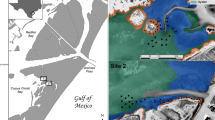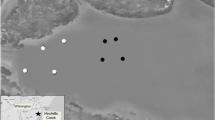Abstract
The culture of the Eastern oyster (Crassostrea virginica) in containment gear has become a viable component of restoration programs in many states on the East Coast of the United States, and it has been suggested that these operations may provide many of the same ecological services as natural or restored reefs. Our two-part study comparing the diversity and abundance in macro-epifaunal communities associated with a sub-tidal-created oyster reef and ‘modified rack and bag’ cage system (Part I) and floating oyster cages for restoration (Part II) occurred over the summer and fall of 2006 and 2007, respectively. In Part I, a greater total abundance and species richness (P < 0.05) was found to be associated with the cages, but greater evenness (P < 0.05) was found on the reef. No significant difference (P > 0.05) was found in species diversity according to Simpson’s index by habitat type, but it was significant (P < 0.05) by month. These samples were dominated by naked goby (Gobisoma bosc) and Atlantic mud crab (Panopeus herbstii). Spaghetti worm (Ampharetidae, P < 0.01), sheepshead (Archosargus probatocephalus, P < 0.01), blue crab (Callinectes sapidus, P < 0.01), grey snapper (Lutjanus griseus, P < 0.05), gag grouper (Mycteroperca microlepis, P < 0.01), and Atlantic oyster drill (Urosalpinx cinera, P < 0.05) were unique to the cages, while the skilletfish (Gobiesox strumosus) was unique to the reef. Part II revealed that the floating cages supported 13 species of fish and invertebrates, although no significant differences in species richness, evenness, or diversity were found by month or by bay area (P > 0.05). These results suggest that created reefs in conjunction with ‘rack and bag’ cage systems, as well as floating cage systems, support ecologically and economically important macro-epifauna, even at very small scales.





Similar content being viewed by others
Abbreviations
- SAV:
-
Submerged aquatic vegetation
- MSX:
-
Multinucleated sphere X
- CIB:
-
Center for the Inland Bays
- PVC:
-
Poly-vinyl chloride
- USDA:
-
United States Department of Agriculture
References
Breitburg DL (1999) Are three-dimensional structure and healthy oyster populations the keys to an ecologically interesting and important fish community? In: Luckenbach MW, Mann R, Wesson JA (eds) Oyster reef habitat restoration: a synopsis and synthesis of approaches. Virginia Institute of Marine Science Press, Gloucester Point, pp 239–250
Brumbaugh RD, Sorabella LA, Garcia CO, Goldsborough WJ, Wesson JA (2000) Making a case for community-based oyster restoration: an example from Hampton Roads, Virginia, U.S.A. J Shellfish Res 19(1):467–472
Chaillou JC, DeMoss TE, Eskin R, Kutz FW, Magnien R, Mangiaracina L, Maxted J, Price K, Summers JK, Weisberg SB (1994) Assessment of the ecological condition of the Delaware and Maryland coastal bays. US Environmental Protection Agency, Region III, Annapolis
Clarke KR, Warwick RM (1994) Changes in marine communities: an approach to statistical analysis and interpretation. Plymouth Marine Laboratory, Plymouth, p 859
Delaware Inland Bays Estuary Program (1993) Science and Technical Advisory Committee Characterization Summary. Delaware Inland Bays Estuary Program, Dover, Delaware
Erbland PJ, Ozbay G (2008) A comparison of the macrofaunal communities inhabiting a Crassostrea virginica oyster reef and oyster aquaculture gear in Indian River Bay, Delaware. J Shellfish Res 27(4):757–768
Goldsborough W, Merritt D (2001) Oyster gardening for education and restoration. Prepared by: Maryland Sea Grant College Program for the Oyster Alliance
Harding JM, Mann R (1998) Oyster reef restoration as a habitat enhancement tool for recreationally valuable finfishes. J Shellfish Res 17:1302
Harding JM, Mann R (2000) Estimates of naked goby (Gobiosoma bosc), striped blenny (Chasmodes bosquianus), and eastern oyster (Crassostrea virginica) larval production around a restored Chesapeake Bay oyster reef. Bull Mar Sci 66(1):29–45
Kennedy VS (1996) The ecological role of the Eastern oyster, Crassostrea virginica, with remarks on disease. J Shellfish Res 15(1):177–183
Kilpatrick BD (2002) Assessing habitat value of modified rack and bag aquaculture gear in comparison with submerged aquatic vegetation and a non-vegetated seabed. Masters thesis, University of Rhode Island
Leight AK, Scott GI, Fulton MH, Daugomah JW (2005) Long term monitoring of grass shrimp Palaemonetes spp. population metrics at sites with agricultural runoff influences. Int Comp Biol 45:143–150
Luckenbach MW, O’Beirn FX, Taylor J (1999) An introduction to culturing oysters in Virginia. School of Marine Science, Virginia Institute of Marine Science College of William and Mary, Virginia
Messick G, Casey J (2004) Chapter 8.6. Status of blue crab, Callinectes sapidus, populations in the Maryland Coastal Bays. In: Maryland’s Coastal Bays: Ecosystem Health Assessment, DNR-12-1202-0009. Maryland Department of Natural Resources, Annapolis, Maryland
Newell RIE (2004) Ecosystem influences of natural and cultivated populations of suspension-feeding bivalve mollusks: a review. J Shellfish Res 23(1):51–61
O’Beirn FX, Ross PG, Luckenbach MW (2004) Organisms associated with oysters cultured in floating systems in Virginia, USA. J Shellfish Res 23:825–829
Peterson CH, Grabowski JH, Powers SP (2003) Estimated enhancement of fish production resulting from restoring oyster reef habitat: quantitative valuation. Mar Ecol Prog Ser 264:249–264
Pollock LW (1998) A practical guide to the marine animals of northeastern North America. Rutgers University Press, New Brunswick
Rothschild BJ, Ault JS, Goulletquer P, Heral M (1994) Decline of the Chesapeake Bay oyster population: a century of habitat destruction and overfishing. Mar Ecol Prog Ser 111:29–39
Scotto SL, Biggs RB, Brown B, Manus AT, Lyman JM (1983) Decisions for Delaware: Sea Grant looks at the Inland Bays. Marine Advisory Service, University of Delaware Sea Grant College Program
Shumway SE, Davis C, Downey R, Karney R, Kraeuter J, Parsons J, Rheault R, Wikfors G (2003) Shellfish aquaculture—in praise of sustainable economies and environments. World Aquac 34:15–18
Smullen J (1992) Water quality of Inland Bays. Roy F. Weston, West Chester
University of Delaware Citizen Monitoring Program (UDCMP) (2008) Water Quality Reports—2008. Available online at: http://citizen-monitoring.udel.edu/reports.shtml
Acknowledgments
We would like to thank Dr. Gulnihal Ozbay for acquiring funding for these projects and the endless support she provides to her graduate students. Thanks go to Mr. John Ewart of Delaware Sea Grant for facilitating the oyster gardening program and obtaining the oysters via the University of Maryland Center for Environmental Science, Horn Point Laboratory, for this research. Thanks go to Dr. Douglas Miller for his assistance in the experimental design and Dr. Ed Whereat of the University of Delaware for his expertise with water quality and the use of his laboratory for the processing of samples. Thanks go to the Center for Inland Bays for the use of their oysters, oyster reef, oyster aquaculture gear, and pontoon boat. Special thanks go to Ms. Kate Rossi-Snook, whose tireless and inspirational efforts, ideas, and support during the 2007 field season cannot be overemphasized. This project was funded by a grant from the USDA/CSREES 2004 38820-15154 and the USDA Evans-Allen Grant awarded to Dr. Gulnihal Ozbay.
Author information
Authors and Affiliations
Corresponding author
Rights and permissions
About this article
Cite this article
Marenghi, F., Ozbay, G., Erbland, P. et al. A comparison of the habitat value of sub-tidal and floating oyster (Crassostrea virginica) aquaculture gear with a created reef in Delaware’s Inland Bays, USA. Aquacult Int 18, 69–81 (2010). https://doi.org/10.1007/s10499-009-9273-3
Received:
Accepted:
Published:
Issue Date:
DOI: https://doi.org/10.1007/s10499-009-9273-3




